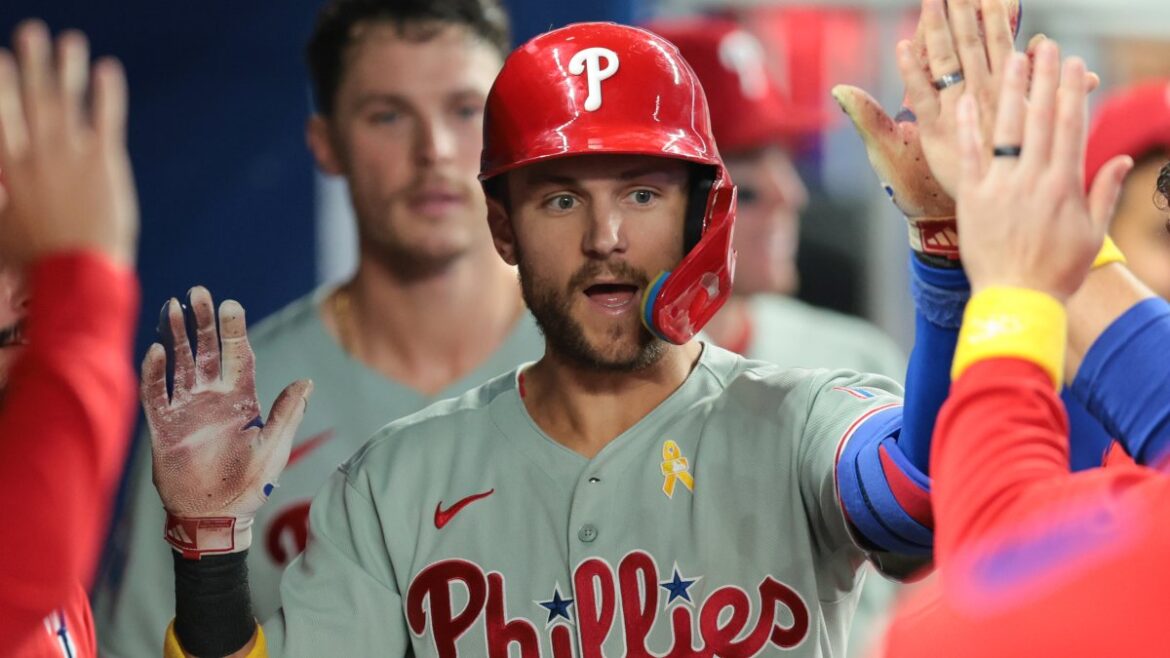It was another steady campaign for Trea Turner.
A .304 average, 179 hits, 94 runs and 36 stolen bases. The shortstop earned his second career batting title — as the only hitting in the National League to eclipse .300 — and reminded everyone why he’s one of baseball’s best shortstops.
He was just as sharp in the field — arguably as sharp as he’s ever been. Turner posted 17 Outs Above Average in 2025 which was tied for third among all shortstops and in the 99th percentile leaguewide.
This was easily his best season since joining Philadelphia.
For the first time since Richie Ashburn in 1958, a Philadelphia Phillie won the National League batting title. Turner reflects on a remarkable season, batting .304 on the year.
Now comes the challenge.
Set to earn $27.2 million, Turner enters his age-33 season in 2026, and the question is whether he can keep producing at that level.
Based on history and his profile, there’s reason to believe the 32-year-old, who turns 33 on June 30, can.
Since 2000, 27 shortstops have recorded at least 500 plate appearances at age 32, and 19 have done so at 33. The drop-off between the two age groups has been mild. The average slash line at 32 is .277/.337/.422; at 33, it’s .266/.331/.404.
If Turner followed that trend, a projected .293/.349/.439 line (.788 OPS) would still rank among the top National League shortstops — second, in fact, based on 2025 OPS marks.
Still, some of Turner’s underlying data points toward regression. According to Baseball Savant, his 42.1% hard-hit rate ranked in the 44th percentile — his lowest qualified mark of his career — and his 5.8% barrel rate (22nd percentile) tied a career low.
Turner’s hitting profile is unconventional. His chase, whiff and walk rates all sit below league average, yet he consistently produces. The approach isn’t built for power — and that’s fine with the Phillies.
“I don’t care about home runs,” manager Rob Thomson told On Pattison back in May. “We’ve got plenty of guys that can do that. I want you to get on base.”
Turner did exactly that, and there’s little reason to expect it to change.
President of Baseball Operations Dave Dombrowski even echoed that sentiment during the end-of-season press conference when asked about Turner potentially trying to incorporate more power. “We don’t need more pop. His numbers were phenomenal,” he said. “He’s tough on himself; that’s great. But he doesn’t have to give us any more offense than he did.”
Credit: Jayne Kamin-Oncea – Imagn Images
Defensively, his turnaround was dramatic.
In his first two seasons with the Phils, he tallied -9 OAA with 40 errors. Disappointing numbers from a $300 million shortstop.
In 2025, Turner’s +11 fielding run value was tied for 18th among all defenders in baseball.
His improvement can be attributed to and coincided with a closer relationship and more work with infield coach Bobby Dickerson during Spring Training, as detailed by The Athletic’s Matt Gelb in March.
Whatever adjustments he made, they stuck — a positive sign as he ages at one of the game’s most demanding positions.
The only real concern is health. Turner has dealt with hamstring strains in both legs the past two years. His speed remains elite — 100th percentile sprint speed this past season — but that makes lower-body maintenance essential. Hamstrings tend to linger, and the Phillies will likely manage his workload carefully.
While his contract outlook may not be pretty, as he’s signed through his age-40 campaign in 2033, Turner’s outlook for 2026 is simple: stay healthy and stay consistent. If he does both, another batting title — and maybe his first career Gold Glove — could be within reach.
